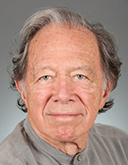Our Team

Chester Alper, MD
Senior Investigator, PCMM
Professor of Pediatrics, Harvard Medical School
Dr. Chester Alper received his M.D. from Harvard Medical School in 1956. In addition to practicing medicine in the late 1950s, both in the U.S. Navy and while completing his Harvard Medical Services internship and residency at the Boston City Hospital, Dr. Alper trained in basic protein techniques in Albert Coons’ laboratory at Harvard. In the early 1960s, he studied human serum proteins with a USPHS postdoctoral fellowship in Sweden under the guidance of Jan Waldenström and Carl-Bertil Laurell at the Malmö allmänna sjukhus. In the 1960s, as a research associate in Medicine, Dr. Alper conducted medical research both at the Peter Bent Brigham Hospital and the Children's Hospital —collaborating in some cases with the then-Children's Hospital Physician-in-Chief, Dr. Charles A. Janeway, and Dr. Fred Rosen. In 1965, Dr. Alper joined the Children's Hospital Blood Grouping Lab (BGL), then under Dr. Louis K. Diamond, where Dr. Alper added serum protein analysis to clinical testing. This helped support other research activities and provided patient material for research. As a result, Dr. Alper detected the first described genetic polymorphism in a complement protein, C3, that led to his pioneering the field of complement genetics. In 1969, he was appointed an Associate Professor of Pediatrics and, in 1970, as an Associate in Hematology at the Children’s Hospital/Harvard Medical School. Dr. Alper was promoted in 1975 to Professor of Pediatrics, Harvard Medical School.
In 1971, Dr. Alper became the Scientific Director of the BGL. In 1972, in a reorganization by Dr. Janeway, the BGL merged with the Blood Research Institute (formerly, the Protein Foundation) to become the new Center for Blood Research (CBR) — to which Dr. Alper was named Scientific Director (until 1993). While at BGL and in the early years at CBR, Dr. Alper devised immunofixation, a precursor of Western blotting, for clinical detection of serum proteins, and he, in collaboration with Dr. Robert Ritchie, automated immunonephelometry to replace manual gel methods for serum protein measurement in clinical laboratories worldwide.
From the 1970s into the 21st century, as CBR transformed, eventually, into what is now PCMM at Boston Children's Hospital, Dr. Alper's research focus switched from hematology to immunology focused on protein products to immunogenetics. Propelled by the fact that some complement proteins are encoded by genes (C2, C4A, C4B, and CFB) in the human major histocompatibility complex (MHC), Dr. Alper began an intense study of this genomic region in relation to autoimmune disease and other immune phenomena. In the 1980s, Dr. Alper found that these complement genes formed a haplotypic unit (the complotype), and this in turn led to his group's recognition of long fixed segments of MHC DNA, conserved extended haplotypes (CEHs). He published the first family study of the MHC in type 1 diabetes (T1D; to provide intrafamily control haplotypes as ethnically matched to the patients’ as possible). That study showed that all of the MHC susceptibility and protective markers for T1D were parts of a few CEHs. In 1989-90, he obtained a Guggenheim Fellowship to study molecular biology on sabbatical leave in a laboratory at the Rockefeller University. Dr. Alper also won a 10-year NIH MERIT Award from NIAID in 1990, and, in 1998, he was named the Honorary Congress President of the VIIth Complement Genetics Workshop and Conference in Mainz, Germany.
Currently, Dr. Alper's laboratory focuses on two areas. The first is devising new techniques to analyze the structure of common population-level CEHs using pedigree-phased haplotypes, with a focus on the MHC. The other is analyzing MHC polymorphisms to identify the genetic and epigenetic mechanisms underlying susceptibility to and the causal trigger(s) of T1D. Recently, the latter has focused on a large international consortium biorepository and database to which we contributed, the Type 1 Diabetes Genetics Consortium.
Instructor
 |
Charles Larsen, PhD Charles trained in both protein chemistry and the biophysics of viral membrane fusion with a focus on model membranes (liposomes). His current research is on population-level genomic sequence architecture of the human MHC, based on pedigree-phased haplotype analysis, and its relationship to susceptibility genes for complex autoimmune disease — with a focus on type 1 diabetes. |
Staff
 |
Lori Brizuela, BS Using an international type 1 diabetes (T1D) genetic database, Lori is applying her background in biostatistics to help refine and use analytical methods for pedigree-based human MHC haplotype structure detection and T1D genetic association. She shall be applying these methods to long-range DNA sequence data. |
